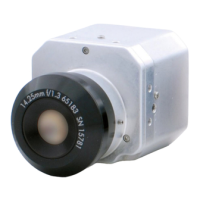51
History and Theory of Infrared Technology
the wavelength calculated for λ
max
. A
good approximation of the value of µmax
for a given blackbody temperature is
obtained by applying the rule-of-thumb
3,000/T µm. Thus, a very hot star such as
Sirius (11,000 K), emitting bluish-white
light, radiates with the peak of spectral
radiant emittance occurring within
the invisible ultraviolet spectrum at
wavelength 0.27 µm.
The sun (approx. 6,000 K) emits yellow
light, peaking at about 0.5 µm in the
middle of the visible light spectrum.
At room temperature (300 K) the peak
of radiant emittance lies at 9.7 µm in the
far infrared, while at the temperature of
liquid nitrogen (77 K) the maximum of the
almost insignicant amount of radiant
emittance occurs at 38 µm in the extreme
infrared wavelengths.
By integrating Planck’s formula from
λ = 0 to λ = ∞, we obtain the total radiant
emittance (W
b
) of a blackbody:
Wb = σT
4
[Watt/m
]
This is the Stefan-Boltzmann formula
(after Josef Stefan and Ludwig
Boltzmann, shown in Figure 11), which
states that the total emissive power of a
blackbody is proportional to the fourth
power of its absolute temperature.
Graphically, Wb represents the area
below the Planck curve for a particular
temperature. It can show that the radiant
emittance in the interval λ = 0 to λ
max
is
only 25% of the total, which represents
Figure 9. Wilhelm Wien (1864–1928)

